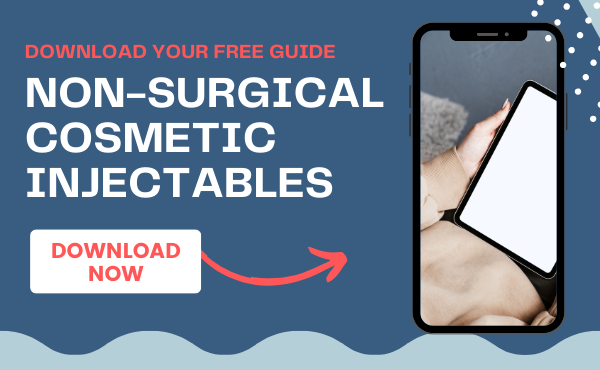Dermal Filler – Facial Volumisers by Dr Kernohan Plastic Surgeon
Fine lines and wrinkles are a natural part of ageing. Dermal fillers and facial volumisers can help fill in wrinkles and lines.
Specialist Plastic Surgeon Dr Michael Kernohan offers surgical and non-surgical treatments in 5 convenient locations in Southwest Sydney and Southern Ranges NSW.
CLICK to Download Dr Michael Kernohan Cosmetic Injectables Guide

Causes of Facial Volume Loss
A number of factors can contribute to facial volume loss such as the following:
- Ageing
- Dehydration
- Genetics
- Loss of bone mass
- Prolonged sun exposure
- Smoking
- Too much dieting and/or exercise
- Underlying medical conditions
Benefits of Dermal Fillers and Volumisers
The filler treatments offer the following benefits:
- Faster treatment than a facelift
- Can gently transition over time with a gradual pace of treatment
- Highly customisable to your needs
- See immediate results
- Little to no discomfort during injectables
- Lower risk of complications compared to surgery
- No incisions or stitches
- Minimal recovery time needed
- Reduced appearance of fine lines, wrinkles, and other sunken facial areas
How Dermal Fillers and Volumisers Work
Injectable dermal fillers and volumisers produce a similar effect on your skin. However, they are used for specific purposes. Dermal fillers use a naturally-occurring substance in your body that is responsible for maintaining skin hydration. The substance draws water to certain skin areas and fills in fine lines, wrinkles, scars, and other depressions in the target area.
Volumisers, on the other hand, add volume and fullness to your face but do not necessarily address skin depressions. They work by stimulating the production of collagen in your skin. Collagen is a special protein that is responsible for maintaining the structures of your skin. When injected into your skin, it smooths out fine lines, wrinkles, and other skin concerns.
Areas that can be treated with Dermal Fillers and Volumisers
Both of these treatments can address different areas, such as the following:
- Brows
- Cheeks
- Forehead
- Hands
- Jaw
- Lips
- Mouth
- Temples
- Under the eyes
What to Expect after Dermal Fillers and Volumisers
You should expect the following after the treatment:
- A certain level of redness or bruising
- Numbness, swelling, bruising, and tolerable pain at the injection sites are common
- You can resume work and activities of daily living almost immediately
- You can immediately notice an increase in volume and fullness in the treated area
Aftercare for Dermal Fillers and Volumisers
To prevent complications and achieve desired results:
- Apply a cold compress to the treated area for 5-10 minutes in case of discomfort
- Avoid bending over
- Avoid hot environments such as saunas
- Avoid other skin treatments such as facials or chemical peels for at least 24 hours after the procedure
- Avoid placing any pressure or tension on the treated area
- Do not massage the treated area
- Drink plenty of water and fluids to allow the filler to fully settle into the treated area
- Limit sun exposure
- Remain in an upright position for 3-4 hours after the procedure
- Seek medical help immediately if you experience any signs and symptoms that were not discussed with the doctor
- You will need to avoid alcohol and smoking
- You will need to avoid heavy lifting and strenuous exercise for the first few weeks
- You will need to avoid taking medication or supplements that can increase your risk of bleeding
- You will need to sleep with your head elevated using 2 to 3 pillows
Risks and Complications of Dermal Fillers and Volumisers
The risks and complications are common for most cosmetic or plastic surgery procedures:
- Blocked facial blood vessels
- Changes in skin sensation
- Lumps
- Movement of filler away from the treatment area
- Numbness in the treated area
- Poor cosmetic results
- Unfavourable scarring
Find out more on the plastic surgery risks page.
Good Candidates for Dermal Fillers and Volumisers
You are a good candidate for the procedure if:
- You are a non-smoker
- You are committed to maintaining good skin health
- You are in good overall health
- You have a positive outlook and realistic expectations
- You have lines around your mouth
- You have thin or sunken cheeks due to facial volume loss
- You have thin or uneven lips

Dermal Fillers Cost Sydney – How Much Are Dermal Filler Injections in Sydney?
The price of dermal filler injections in Sydney depends on various factors such as:
- Surgeon’s reputation, level of expertise, qualifications
- What is included in the surgical quote or price estimate
- Where is the procedure performed
- What filler is used and in what amount
- The complexity of each case
Learn more about plastic surgery fees on Dr Kernohan’s pricing page.
Alternatively, you can contact Dr Kernohan’s team for a price estimate or to set up an appointment today.
Funding Your Dermal Fillers Procedure
Find out more details about funding your procedure and payment plans on the financing options page.
How to find the right Dermal Fillers Practitioner in Sydney
The results achieved after getting dermal fillers depend not only on the type of substance used, but also the talent and experience of the person performing the procedure. This is the reason why it’s important to choose a talented and experienced practitioner, and not necessarily one that has the lowest fees.
Always look at their past patient photos and find one that you feel comfortable with.
Dermal Fillers FAQs
How long do dermal fillers last?
- The results of dermal fillers vary from patient to patient. This depends on a number of factors such as your skin condition, desired results, and skincare regimen. Also, the type and amount of filler injected can play a role in the longevity of the results. In general, the results can last from six months up to a year. However, it is not a permanent solution and you will need to undergo touch-up treatments if you want to prolong the results.
At what age should you start getting fillers?
- Your mid-20s are often a good time to start getting fillers if you like to address the signs of ageing.
Are dermal fillers safe?
- Yes. Dermal fillers make use of a naturally-occurring substance in your body that is responsible for maintaining skin hydration. The substance draws water to certain skin areas to fill in depressions and add volume. Because of this, the use of dermal fillers is associated with a lower risk of complications compared to surgery. After the procedure, you will experience some swelling in the treated area but these will just resolve after a few days. In addition, you can directly resume your activities of daily living after the treatment.
How many syringes fill the jawline?
- The amount of filler needed to achieve your desired results will greatly depend on your skin condition. In general, the jawline area will need 2-6 syringes to produce the best clinical outcome. During your consultation, your general health, skin condition, and expectations will be thoroughly assessed to determine the amount of filler needed to achieve your treatment goals.
Do fillers make you age faster?
- If used incorrectly, fillers can make you look older by distorting your face. This is because too much filler can stretch your skin out. In addition, fillers can migrate or move away from the intended body area, resulting in sagging. The reason behind this is that when you inject more filler than your body can hold in one place, the filler will sink down because your skin cannot hold onto the weight of the injected mass. Find out more details about Filler Dissolving Treatment.
Are dermal fillers permanent?
- The vast majority of fillers are temporary because your body absorbs them over time. Once this happens, you will need touch-up treatments.
What should you not do before fillers?
To achieve the results you want, there are some preparations that you need to do before your dermal filler treatment. These include the following:
- Avoid prolonged sun exposure
- Do not drink alcoholic beverages
- Do not smoke
- Do not take medications or supplements that can increase your risk of bleeding
- Do not use hair removal products in the treatment area
- Talk to your dermal filler practitioner regarding your health to determine any contraindication to the treatment (e.g. pregnancy, breastfeeding, bleeding disorder, or an active skin infection)
How do you sleep after fillers?
- After the treatment, the main goal is to prevent placing any tension or pressure on the treated area. To do this, you will need to sleep on your back with your head elevated using 2 to 3 pillows for 3 nights. You can also use a wrap-around neck pillow to stabilize your head when you sleep. By doing this, the treated area will remain free from any pressure and the filler will settle normally, thus, preventing the formation of any lumps.
Which filler lasts the longest?
- Fillers are temporary because your body absorbs them over time. They only last for 6 to 12 months. Once this happens, you will need touch-up treatments.
How often should you get dermal fillers?
- The recommendation is to undergo touch-up treatments every 6 to 12 months.
Will 1 ml cheek filler make a difference?
An amount of 1 ml of cheek filler will produce a noticeable but still natural result. However, it is important to keep in mind that the amount of filler injected will be different for every person and will depend on the following factors:
- Amount of volume loss in the target area
- Depth of wrinkles
- The shape and features of your face
- Type of filler treatment
How long do fillers take to work?
- Dermal fillers produce immediate results. After the treatment, you can notice that the treated area has significant improvement with regard to volume and fullness. However, you will need to wait for up to 4 weeks to see the final results of the treatment. This is the time required for the filler to fully settle or integrate into the tissues of the treated area.
What are the side effects of fillers?
- After the procedure, you will likely experience redness, swelling, bruising, and tenderness in the treated area. These are just temporary and will resolve after a few days. In case of discomfort, you can apply an ice compress to the treated area.
How long do hyaluronic fillers last?
- If you are getting dermal fillers for the first time, hyaluronic fillers are right for you. They tend to be the most temporary option and last about 6 months. This filler is made from hyaluronic acid, a naturally-occurring substance in your body that helps maintain skin hydration by locking in moisture.
Further Reading and Medical References about Dermal Fillers:
· Current Applications of Facial Volumization with Fillers





